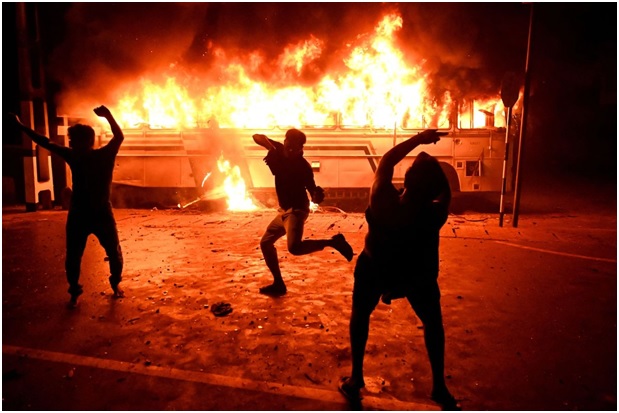
Sri Lanka is in flames. This time it is not an ethnic conflict, but the hunger and despair of a people, whose government, greedy for personal wealth and committed almost exclusively to the genocide of the Tamil minority, has led the state to default – to bankruptcy. Sri Lanka cannot pay its debts: first the fuel ran out, then the food and medicine, then the water, then the banks stopped working. The debt chasm has devoured everything. The world looks at this development with great concern, but does not know what to do – and with whom. The Rajapaksa family, after decades of unchallenged rule, is falling apart[1]. People have been protesting in the streets, continuously, increasingly desperate and furious, for more than two months. Prime Minister Mahinda Rajapaksa resigned on 9 May 2022[2]. In Colombo, on 31 March, an angry mob pushed its way to the house of President Gotabaya Rajapaksa[3] – Mahinda’s brother – demanding his resignation: the riots were repelled with water cannons and tear gas, 50 people ended up in hospital. The government declares a state of emergency and arrests 600 people[4].
The external debt now amounts to almost 51 billion dollars[5]. For days, longer and longer queues of people have been appearing at petrol stations with no more fuel; there is a shortage of gas for cooking, there is a shortage of medicine, the means of transport have collapsed; the government suspends electricity for thirteen hours a day, hospitals stop working: they have no diesel for the generators; there is a shortage of food, supermarkets without electricity cannot store food, the telephone network and the internet suffer constant interruptions. It is the worst crisis in 1948: among the reasons certainly the Covid19 epidemic, the Ukrainian crisis, but the real responsibility for the disastrous situation lies with the government, totally incapable of managing the economy. Citizens accuse the Rajapaksa family, which has controlled politics since 2005, of corruption, nepotism and authoritarianism.
A complex ethnic and religious mosaic
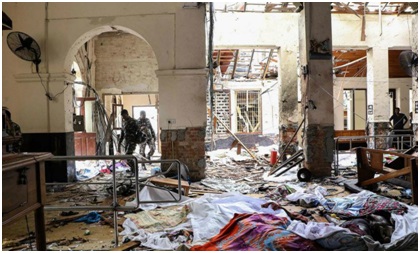
Scene of the Easter 2019 attacks, in which 270 people died: to date the action has gone unpunished[6]
Sri Lanka suffers endemically from inter-ethnic tensions: the Sinhalese, who with 74.9% of the population – about 15 million people – constitute the majority community, are divided not only by caste differences, but also by religious and cultural differences. Although the overwhelming majority is Buddhist (over 70%)[7], the Hindu (12.6%)[8] and Muslim (9.7%)[9] communities are still important. Nevertheless, Christians (just 1.3%)[10] are those who hold the reins of power. Then there are the Tamils, divided into two groups, one of Sri Lankan origin and one Indian, of predominantly Hindu and Christian religion[11]. Among the Hindus, the ancient caste system operates more rigidly than among the Sinhalese[12].
The Muslim community divides and is divided into three groups: the oldest is the Sri Lankan Moors, the second is the Malays, brought there by the Dutch in the 17th and 18th centuries; the third and last group comprises the Indian Moors, most of whom are ethnic Tamils from southern India[13]. There are increasing reports of discriminatory attitudes and practices towards the Muslim community: during the pandemic, for example, the authorities banned the burial of Covid victims, forcing them to undergo cremation, a rite prohibited in Islam[14]. In 2020, the government banned the use of the burqa and all other forms of face covering under the pretext of national security[15]; more than 1,000 Islamic religious schools were closed, contrary to national education policies[16].
The rancour against Muslims grew especially after the simultaneous attacks on Easter Sunday 2019[17], which ripped through three churches and as many hotels, killing almost 270 people, including 45 foreign nationals: the worst attack in Sri Lanka’s history. Responsibility was very hastily attributed to local armed groups affiliated with ISIL (ISIS)[18], although after three years of investigation, no truth has yet been arrived at. Recently, Cardinal Malcolm Ranjith, head of the Sri Lankan Catholic Church, said that, based on what has emerged from the investigation so far, it seems that a ‘political conspiracy’ was behind the attacks[19].
A quarter of a century of persecution and massacres
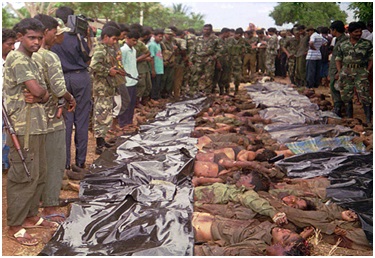
28 July 1995: the bodies of 182 Tamils, killed in a civil war clash that cost more than 130,000 lives[20]
The Sri Lankan civil war is one of the many forgotten wars in the world, one that the international community has ignored for too long. Lasting more than 25 years, it has cost more than 130,000 lives (146,679 missing, almost all of them probably dead[21]), and is a war born out of the ‘divide and rule’ policy applied by the colonial forces. Twice the size of Belgium, Sri Lanka is the 25th largest island in the world and is immersed in the Indian Ocean. Only 33 km away from India, the two regions were once connected by the Adam’s Bridge, which spanned the Palk Strait, it is not known whether natural or artificial. Even today, many traces of it remain and mythology has it that an army of monkeys built it at the behest of the Hindu deity King Rama[22].
According to scripture, Sri Lanka has been an independent kingdom since its foundation in 438 BC, when an Aryan prince from India landed on the island and established his kingdom in the north-central plain[23]. This was followed over time by a series of major invasions and minor incursions by various dynasties in southern India, during the reigns of Anuradhapura and Polonnaruwa, up to the 12th century, until the last reign of Kandy in the 16th century[24]. With the capture of the King of Kandy on 19 February 1815, the island of Sri Lanka, then called Ceylon by the Europeans, lost its independence of 2357 years and became a British colony[25].
At that time Ceylon had about three million Sinhalese, mostly Buddhists, and 300,000 Hindu Tamils[26]. British colonialism, chasing profits, builds huge coffee, rubber and tea plantations, quickly settling about one million ethnic Tamils from neighbouring India to employ them as labourers[27]. Schools are founded for them, and they are also granted numerous bureaucratic functions: this disproportion in favour of the British fuels the wrath of the Sinhalese majority who, with independence, will implement anti-Tamil policies. In that historical phase, the Tamils of Indian origin made up little more than half of the entire Tamil ethnic group and were considered by the government as ‘non-Srilankese’, and deprived of the right to vote: with the Ceylon Citizenship Act of 1948[28], Indian Tamils were effectively banned from holding citizenship, so that 700,000 became stateless.
In 1956, the Official Language Act No. 33, or Sinhala Only Act, was enacted, establishing Sinhalese as the only official language of Ceylon, thus excluding Tamil. Parts of the act were revoked in 1958 with the compromise ‘Sinhalese only, Tamil also’: the ‘special provision’ certainly represents a small step forward, but does not establish real equality at all. This puts ethnic Tamils at a serious disadvantage: every Tamil in a civil service is compulsorily retired, and those seeking employment in the state administration have no choice but to learn the official language. These measures would contribute to a decisive increase in hostilities between Sinhalese and Tamils, until, in 1983, the first uprisings began in the city of Colombo and other cities.
The Tamil Tigers
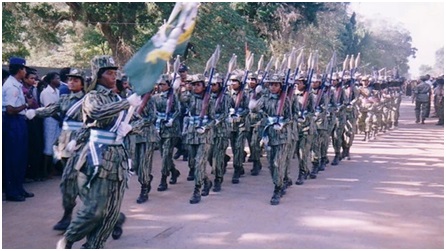
Parade of the female wing of the Tamil Tigers, also trained to carry out suicide attacks[29]
The protagonist of the insurrections is the Liberation Tigers of Tamil Eelam (LTTE) army, whose charismatic leader is Velupillai Prabhakaran, who is inspired by Alexander the Great and Napoleon[30]. The Tigers started in the 1970s as a small movement of the Tamil community against discrimination and injustice – and in a few years became an organised army of about 30,000, with a suicide squad – the first to use female suicide bombers and explosive belts[31] – among the most ruthless in the world.
It enjoys a vast international support that provides weapons and money: the Tamil diaspora, which runs dozens of organisations around the world and at least thirty-two companies disguised as charities[32]. They are partly criminal organisations, specialising in maritime piracy, human trafficking, drugs and weapons, which earn millions through extortion and forgery of passports and credit cards – an annual turnover of between 200 and 300 million dollars[33].
The group’s goal is to achieve armed secession in order to create a sovereign socialist Tamil state in the north and east of the island[34]. On 1 July 1983, in the midst of riots against the government – riots that, for the first time, united traditionally conflicting religious groups[35] – the Tamil Tigers attacked a unit of the regular army, killing 13 soldiers and wounding 37[36]: the attack provoked violent reactions from the Sinhalese, which cost the lives of at least 3,000 Tamils killed and an unknown number of displaced persons[37]. The Tamil Tigers then declared the beginning of the ‘First Eelam War’, which lasted until 1987, during which time the separatists used car bombs, landmines and explosive belts against Sinhalese military and civilian targets. Indian Prime Minister Indira Gandhi’s mediation, later accused of fostering the Tamil Tigers themselves[38], failed, and the Sri Lankan army captured, tortured and killed thousands of Tamil civilians – a genocide.
In 1987, the Indian Prime Minister Rajiv Gandhi, worried that separatist pressures might spread in his own country, decided to send a peacekeeping force of 100,000 soldiers (IPKF)[39]: the action turned out to be a failure, costing the lives of 1,200 soldiers and strengthening the separatists[40], and in revenge, the Tamil Tigers organised numerous attacks on Indian territory[41]. In May 1990, the Sri Lankan President, Ranasinghe Premadasa, forced India to recall its military forces[42]; the withdrawal left the Tigers in control of vast areas of northern Sri Lanka[43]. A year later a female suicide bomber kills Rajiv Gandhi during an election rally[44]. President Premadasa dies in the same way in May 1993[45].
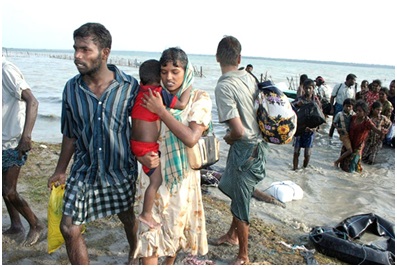
Tamil civilians fleeing the final battle in the Vanni region in 2009[46]
On 19 April 1995, during the second phase of the Eelam War, after a 100-day truce, the Tigers attacked the north-eastern port of Trincomalee, in a suicide attack that killed 12 sailors and blew up two gunboats[47]. The following December, the Sri Lankan army launched an attack to conquer Jaffna: after two weeks of fighting and a huge number of civilian (including those taking refuge in synagogues[48]) and military casualties, the Sri Lankan army managed to capture key towns such as Atchuveli, Avarankal and Puttur[49].
On 8 October 1997, the United States declared the LTTE a terrorist organisation[50]. Great Britain and dozens of other countries followed suit in 2001[51], when the LTTE launched yet another attack by flying a light aircraft over the civilian airport in Colombo, dropping several bombs and destroying about half of Sri Lanka’s air fleet[52]. Years more passed between attacks and guerrilla actions, killing civilians, military and state officials. Norway guarantees a truce process that is systematically obstructed by the government in Colombo – which accuses the Europeans of supporting the separatist forces[53].
During the final stages of the war, government forces encircled the Tamil Tigers in a tiny stretch of land in the north-eastern area of Vanni, together with hundreds of thousands of ethnic Tamil civilians: a fierce battle ensued, during which civilians were used as human shields, killed, tortured, children used as reserves in military counter-actions, with hospitals and places of worship bombed[54], women raped, access to food, water and medicine obstructed[55]. The three No Fire Zones established to facilitate the flight of civilians will be of no use: the NFZs will be repeatedly bombed by the government army itself, sowing thousands of deaths[56]: the last three months of the war will be remembered as the ‘Mullivaikkal Massacre’, an attempted genocide against the Tamil people[57].
The situation for the Tamil Tigers became increasingly difficult, and plans for surrender began to be discussed among them. On 18 May 2009 the turning point: the supreme commander of the Tamil Tigers, Prabhakaran, is killed by government forces in a battle in the coastal village of Mullivaikkal in Mullaittivu[58]. Captured alive, he is executed on the spot with a shot to the head at close range[59]. Several soldiers of his army, arrested and captured, will suffer the same treatment[60]: by now war crimes are no longer counted. The following day Sri Lanka declares the end of the war[61].
The abuses continue
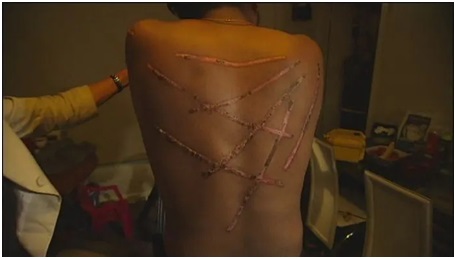
After the end of the war, there will be many reports of rape and torture perpetrated against Tamils[62]
On 13 March 2009, with the war still in progress, the UN Human Rights Council accuses both sides of war crimes: the Foreign Minister denies the accusations but at the same time prevents humanitarian agencies and observers from entering the country to carry out the necessary checks[63]. The end of the war does not put an end to the atrocities: a report[64] released in 2014 by the lawyer Yasmin Sooka (later threatened by the Sri Lankan intelligence[65]) speaks of continued severe persecution of the Tamils. It collects numerous testimonies of abuse, including forced oral sex, anal rape and water torture, beatings, burnt with cigarettes and branded with hot objects, brutalities carried out by or with the complicity of Sri Lankan officials[66]. A sad reality emerges from the report: still five years after the silencing of weapons, genocide continues. On 16 September 2016[67], the United Nations Office of the High Commissioner for Human Rights (OHCHR)[68] ‘OISL Report’ is published, which speaks of a ‘horrific level of violations and abuses’ and presents evidence of violations by government forces, pro-government paramilitaries and the LTTE: indiscriminate bombing of hospitals, UN centres and ships belonging to the Red Cross International Aid Group[69], extrajudicial executions, enforced disappearances, torture and sexual violence, recruitment of children, civilians used as human shields and denial of humanitarian assistance[70]. The report confirms the accounts, provided by victims and survivors, of war crimes committed systematically during the last, brutal months of the civil war and immediately afterwards[71].
The report states that the violations perpetrated by both the government and the LTTE amount to crimes against humanity[72]. The report contains a number of recommendations on how Sri Lanka can lay the foundations for sustainable peace[73]. The government of national unity, which comes to power in 2015, adheres to Resolution 30/1 and promises to resolve the issue. But things do not change, and the UN adopts two new resolutions (34/1 in March 2017 and 40/1 in March 2019)[74]. It gets worse with the new government of President Gotabaya Rajapaksa: in February 2020 he even withdraws from the Human Rights Council[75].
The ‘Sri Lanka Campaign for Peace & Justice’ movement, in its report of February 2021, denounces a bleak situation: the vast majority of the commitments made by the government have remained on paper, and only one of the four key justice instruments promised is operational[76]. By contrast, almost nothing has been done to counter the culture of impunity, deeply rooted in Sri Lanka, an issue at the centre of cyclical outbreaks of mass violence[77]. In March 2022, the UN High Commissioner for Human Rights Michelle Bachelet denounced the government’s inability to establish accountability for the atrocities committed by the army against Tamil civilians[78].
Bachelet speaks of a country that “has taken the path of militarisation” and does everything in its power to cover up the crimes committed and erode democratic spaces: she therefore calls for “exploring the possibility of targeted sanctions against those allegedly responsible for serious human rights violations and abuses”[79]. In the Tamil majority area of the island, the extermination continues: 146,679 missing, more than 40,000 murdered, violent repression of journalists, activists, lawyers, the destruction of cemeteries of Tamil war heroes and the prohibition of memorial events, the construction of Buddhist temples to promote Tamil cultural extinction; the damage to agriculture and fishing[80]. It is a definite pattern that began in 1983 and shows no sign of ending[81].
History of the Rajapaksa clan
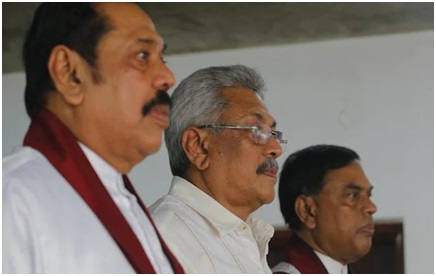
Former Sri Lankan President Mahinda Rajapaksa with his brothers: former Defence Secretary Gotabaya Rajapaksa and former Economic Development Minister Basil Rajapaksa[82]
The Rajapaksa clan is a landowning family from the village of Giruwapattuwa, in the southern district of Hambantota, enriched by rice and coconuts. The clan entered politics when Don Matthew Rajapaksa, son of Don David Rajapaksa, was elected to the Hambantota District State Council in 1936[83]: Don Matthew died in 1945 and his brother Don Alvin Rajapaksa won the by-election without any opposition[84]. In the 1947 elections, two family members won in the Hambantota district: Don Alvin Rajapakse and Laxman Rajapakse (Don Matthew’s son) [85].
For the next three decades, no one dared challenge the Rajapaksa family. Don Matthew’s second son George, born on 25 December 1936, becomes Minister of Health, Minister of Fisheries, member of the Council of State and of the Senate of Ceylon[86]: he is the grandson of Don Alvin Rajapaksa, founding member of the Sri Lanka Freedom Party, and cousin of Mahinda Rajapaksa[87]. Don Matthew became a Member of Parliament in 1947 and remained there until 1965, holding various ministerial posts[88]. The family occupied the political scene unchallenged until 1977 when, with the UNP’s landslide victory in the 21 July elections, they lost all representation in parliament.
Just over a decade later, however, they were back in the saddle: Mahinda and his brother Chamal were elected in 1989 in the Hambantota district[89]. Former Minister of Labour (1994-2001) and Minister of Fisheries (1997-2001), then Prime Minister under President Chandrika Kumaratunga[90], Mahinda Rajapaksa was elected President in 2005; he appointed his brother Basil Rajapaksa as Presidential Advisor: a brother called ‘Mr. Ten Percent’[91] because of his corruptness[92]. The other brother, Gotabhaya, Defence Secretary, is nicknamed ‘The Terminator’[93] because of his irascibility. Awaiting several corruption trials, his cases will be swept under the carpet thanks to the immunity he gained with his election as President in 2010[94]. The list of his family members that Mahinda Rajapaksa surrounds himself with during his tenure is, however, very long[95].
During his first government, Mahinda Rajapaksa did his utmost to remove the constitutional limits that prevented a third term, thus securing his power for a long time[96]. He inherited a serious economic situation with deep-rooted failures, the offspring of a sick neo-liberalism embraced in 1977 by the United National Party (UNP), which had followed the IMF programme in a slavish and disastrous manner[97]. Mahinda continues with the same wicked management, pursuing progressive indebtedness, dreaming of a new Dubai on Colombo’s Galle Face seafront: the construction of a new ultra-modern city is entrusted to a Chinese state company for 1.4 billion dollars, plus the free rent of two-thirds of the land for a period of 99 years[98]; the agreement includes further failed investments, such as the Hambantota airport, from which only five flights a week take off, and the Hambantota port, costing a billion dollars and practically unused[99]. In total, Rajapaksa borrows about 8 billion dollars from China, which he cannot now pay back[100].
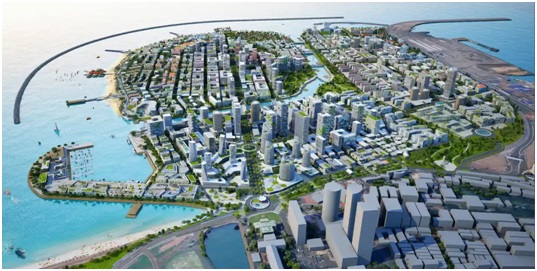
Port City, the Colombo waterfront megacity project[101]
In 2010, Mahinda Rajapaksa, adored by the Sinhalese Buddhist majority for having defeated the Tamil Tigers, was re-elected president[102], bringing with him Nirupama Rajapaksa (Gotabaya’s niece, recently accused together with her husband, Thirukumar Nadesan, of holding millions of dollars in cash scattered around the world, flats and works of art[103]), Basil Rajapaksa (Gotabaya’s brother, former Minister of Economic Development, arrested in 2015 for corruption and embezzlement in relation to a fraud of 70 million rupees, about 530,000 dollars related to the construction of public housing[104]) and Namal Rajapaksa (Gotabaya’s nephew, son of Mahinda, Gotabaya’s brother, Minister of Sports[105])[106]. Soon after, Chamal was elected Speaker of Parliament[107] and Basil Minister of Economic Development[108].
The three Rajapaksa brothers are now in charge of five ministries: Defence, Justice, Economic Development, Finance and Infrastructure – a total of 70% of the national budget[109]. But accusations of corruption weigh heavy: the 2015 elections saw the victory of Maithripala Sirisena, who went into opposition shortly before the vote and benefits from the Tamil and Muslim votes[110]. The new president’s programme is very ambitious: abolish the system of covert powers and corruption, change the constitution to protect the Tamil minorities and investigate the atrocities committed by the authorities during the civil war, including punishing the Rajapaksa family’s sins[111]. But his government does not have the votes to make the reforms, and in the end he appoints Mahinda Rajapaksa as Prime Minister[112]: a betrayal that ends his career[113]. In 2019, the elections are won by Gotabaya Rajapaksa, a former defence secretary and intelligence officer[114].
With Gotabaya comes the coup de grace to an economy already compromised by foreign debt, out-of-control inflation, and a population at the end of its tether. The ruling clan reaps what it has sown with its policy of taking out continuous loans to finance the budget deficit, with the chaos of fiscal regulation, with the inability to invest in exports: in a few months, the entire economy collapses[115]. The attacks, the Covid epidemic and the crisis in Ukraine then brought a huge blow to the tourism sector, the third most important sector for the country[116], since most tourists traditionally come from Russia and Ukraine[117].
This was followed by dastardly measures, such as the blockade of fertiliser imports, which led to a reduction in the harvest of over 30%, forcing the government to issue subsidies[118]; or the reduction of taxes in an attempt to revive the economy[119]; or the madness of banning the import of cars to favour non-existent domestic production[120]. The international crisis brings the last blow, the fatal one: until six months ago, around 18% of GDP consisted of emigrants’ remittances. These are now in trouble, and in just three months the remittances, which were used to support the Sri Lankan currency and allow the banks to have the necessary liquidity for the population, have dropped by more than 35%, and the trend is even more worrying[121]. The reaction of the banks and the government was to increase reliance on foreign bonds (which now make up over 47% of the debt), knowing that they would never be able to honour the interest[122].
The sad epilogue is default. The country, for the first time, cannot repay $78 million in interest on maturing debts. Even more than the Rajapaksas’ lust for power, corruption, political intrigue, and inter-ethnic conflicts, incapacity bordering on stupidity was able to do this. Almost always, nothing can save us from this.
[1] https://www.bbc.com/news/business-61505842
[2] https://www.bbc.com/news/world-asia-61381536
[3] https://www.ndtv.com/world-news/lanka-ex-pm-family-take-shelter-in-naval-base-amid-lethal-protests-over-economic-crisis-2961931
[4] https://www.ndtv.com/world-news/lanka-ex-pm-family-take-shelter-in-naval-base-amid-lethal-protests-over-economic-crisis-2961931
[5] https://tradingeconomics.com/sri-lanka/external-debt
[6] https://asiatimes.com/2019/12/sri-lanka-intel-chief-sacked-over-easter-attacks/
[7] https://www.uscirf.gov/sites/default/files/2021-10/2021%20Sri%20Lanka%20Country%20Update_0.pdf
[8] https://www.uscirf.gov/sites/default/files/2021-10/2021%20Sri%20Lanka%20Country%20Update_0.pdf
[9] https://www.uscirf.gov/sites/default/files/2021-10/2021%20Sri%20Lanka%20Country%20Update_0.pdf
[10] https://www.uscirf.gov/sites/default/files/2021-10/2021%20Sri%20Lanka%20Country%20Update_0.pdf
[11] https://www.britannica.com/place/Sri-Lanka/Plant-and-animal-life#ref388609
[12] https://www.britannica.com/place/Sri-Lanka/Plant-and-animal-life#ref388609
[13] https://www.everyculture.com/South-Asia/Moor-of-Sri-Lanka.html
[14] https://www.hrw.org/news/2021/01/18/sri-lanka-covid-19-forced-cremation-muslims-discriminatory
[15] https://www.aljazeera.com/news/2021/4/28/sri-lanka-cabinet-approves-proposed-ban-on-burqas-in-public
[16] https://www.theguardian.com/world/2021/mar/13/sri-lanka-to-ban-burka-and-close-1000-islamic-schools
[17] https://www.bbc.com/news/world-asia-48001720
[18] https://www.aljazeera.com/news/2019/4/22/hardline-local-group-linked-to-deadly-sri-lanka-attacks
[19] https://www.newsfirst.lk/2022/01/13/grenade-discovery-at-church-a-conspiracy-cardinal/
[20] https://jour210srilanka.wordpress.com/photography/mw2/
[21] https://www.tamilguardian.com/content/12-years-today-massacre-mullivaikkal
[22] https://www.express.co.uk/news/science/829341/adams-bridge-nasa-modern-humans
[23] https://www.colombotelegraph.com/index.php/sri-lankas-sinhalese-tamils-historical-myths-realities/
[24] https://www.colombotelegraph.com/index.php/sri-lankas-sinhalese-tamils-historical-myths-realities/
[25] https://www.sundaytimes.lk/150215/plus/200-years-ago-the-british-marched-into-kandy-135352.html
[26] https://www.thoughtco.com/the-sri-lankan-civil-war-195086
[27] https://indianexpress.com/article/research/indian-tamils-and-sri-lankan-tamils-here-is-the-difference-4654435/
[28] https://www.refworld.org/docid/3ae6b50414.html
[29] https://thediplomat.com/2015/07/sri-lankan-civil-war-what-if-the-tamil-tigers-werent-labelled-as-terrorists/
[30] https://www.aljazeera.com/news/2009/5/19/obituary-velupillai-prabhakaran
[31] https://www.hsdl.org/?view&did=18630
[32] https://www.inss.org.il/wp-content/uploads/sites/2/systemfiles/ShlomiYass.pdf “Sri Lanka and the Tamil Tigers:
Conflict and Legitimacy” – Shlomi Yass – from “Military and Strategic Affairs, Volume 6, No. 2” – August 2014
[33] https://www.inss.org.il/wp-content/uploads/sites/2/systemfiles/ShlomiYass.pdf “Sri Lanka and the Tamil Tigers:
Conflict and Legitimacy” – Shlomi Yass – from “Military and Strategic Affairs, Volume 6, No. 2” – August 2014
[34] https://www.satp.org/satporgtp/countries/srilanka/terroristoutfits/ltte.htm
[35] https://www.ilpost.it/2022/05/13/sri-lanka-crisi-economica-proteste/
[36] https://www.irishtimes.com/news/tamil-tigers-kill-13-soldiers-1.152879#:~:text=Colombo%20%2D%20Suspected%20Tamil%20Tiger%20rebels,detonated%20under%20an%20army%20bus.
[37] https://www.thoughtco.com/the-sri-lankan-civil-war-195086
[38] https://www.firstpost.com/world/indira-gandhi-helped-train-tamil-rebels-and-reaped-whirlwind-13913.html
[39] https://apps.dtic.mil/sti/pdfs/ADA294004.pdf
[40] https://www.sundayguardianlive.com/news/reminiscences-ipkf-peacekeeper
[41] https://www.dailypioneer.com/2015/columnists/25-years-ago-an-exit-following-a-debacle.html
[42] https://www.sundayguardianlive.com/news/reminiscences-ipkf-peacekeeper
[43] https://www.wionews.com/photos/a-timeline-to-tamil-tigers-37-year-marathon-struggle-against-lankan-army-for-separate-state-219592#india-enters-and-leaves-219581
[44] https://www.thehindu.com/in-school/rajivs-death-a-revisit/article5814423.ece
[45] https://www.latimes.com/archives/la-xpm-1993-05-02-mn-30334-story.html
[46] https://www.tamilguardian.com/content/13-years-today-no-fire-zone-smoke
[47] https://www.washingtonpost.com/archive/politics/1995/04/20/sri-lankas-tamil-rebels-blow-up-2-gunboats-ending-truce/4e607351-90d8-4010-9895-5e08792db04f/
[48] https://www.tamilguardian.com/content/fight-jaffna-october-1995
[49] https://www.tamilguardian.com/content/fight-jaffna-october-1995
[50] https://www.refworld.org/docid/5bcf1f33a.html
[51] https://cisac.fsi.stanford.edu/mappingmilitants/profiles/liberation-tigers-tamil-elam#:~:text=July%208%2C%202015-,The%20Liberation%20Tigers%20of%20Tamil%20Eelam%20(LTTE)%20were%20a%20militant,armed%20forces%20in%20May%202009.
[52] https://www.repubblica.it/2007/03/sezioni/esteri/colombo-aeroporto/colombo-aeroporto/colombo-aeroporto.html#:~:text=COLOMBO%20%2D%20Le%20Tigri%20Tamil%20assaltono,altri%2017%20sono%20rimasti%20feriti.
[53] https://thediplomat.com/2015/07/sri-lankan-civil-war-what-if-the-tamil-tigers-werent-labelled-as-terrorists/
[54] https://www.tamilnet.com/art.html?catid=13&artid=29351
[55] https://thediplomat.com/2015/07/sri-lankan-civil-war-what-if-the-tamil-tigers-werent-labelled-as-terrorists/
[56] https://theprint.in/theprint-essential/what-is-mullivaikkal-war-why-has-the-demolition-of-memorial-for-its-victims-triggered-a-row/582976/
[57] https://www.tamilguardian.com/content/12-years-today-massacre-mullivaikkal
[58] https://www.wionews.com/photos/a-timeline-to-tamil-tigers-37-year-marathon-struggle-against-lankan-army-for-separate-state-219592#war-crime-219587
[59] https://www.deccanherald.com/content/6576/prabhakaran-captured-alive-then-shot.html
[60] https://www.deccanherald.com/content/6576/prabhakaran-captured-alive-then-shot.html
[61] https://www.theguardian.com/world/2009/may/18/tamil-tigers-killed-sri-lanka
[62] https://www.colombotelegraph.com/index.php/tamil-man-claims-rape-and-torture-upon-return-to-sri-lanka/
[63] https://edition.cnn.com/2009/WORLD/asiapcf/05/12/sri.lanka.fighting/index.html.
[64] https://barhumanrights.org.uk/wp-content/uploads/2014/03/an_unfinihsed_war._torture_and_sexual_violence_in_sri_lanka_2009-2014_0-compressed.pdf
[65] https://www.fidh.org/en/issues/human-rights-defenders/sri-lanka-public-statement-regarding-allegations-and-threats-against
[66] https://www.theguardian.com/world/2014/mar/21/sri-lanka-tamils-subjected-to-horrific-abuse-after-2009-civil-war-says-report
[67] https://www.crisisgroup.org/asia/south-asia/sri-lanka/statement-un-sri-lanka-investigation-report
[68] https://www.ohchr.org/en/hr-bodies/hrc/oisl
[69] https://www.bbc.com/news/world-south-asia-13190576
[70] https://www.crisisgroup.org/asia/south-asia/sri-lanka/statement-un-sri-lanka-investigation-report
[71] https://www.crisisgroup.org/asia/south-asia/sri-lanka/statement-un-sri-lanka-investigation-report
[72] https://www.srilankacampaign.org/take-action/keep-the-promise/
[73] https://www.srilankacampaign.org/take-action/keep-the-promise/
[74] https://www.srilankacampaign.org/take-action/keep-the-promise/
[75] https://www.thehindu.com/news/international/sri-lanka-notifies-un-about-rights-resolution-withdrawal/article61626417.ece
[76] https://www.srilankacampaign.org/wp-content/uploads/2021/02/Reversing-Progress-Sri-Lanka-Campaign-February-2021.pdf
[77] https://www.srilankacampaign.org/take-action/keep-the-promise/
[78] https://www.asianews.it/notizie-it/L’Onu-accusa-Colombo-di-crimini-di-guerra-55350.html
[79] https://www.asianews.it/notizie-it/L’Onu-accusa-Colombo-di-crimini-di-guerra-55350.html
[80] https://www.einnews.com/pr_news/572102688/tamil-genocide-remembrance-day-may-18-announcement
[81] https://opiniojuris.org/2020/07/24/sri-lankas-state-responsibility-for-historical-and-recent-tamil-genocides/
[82] https://www.business-standard.com/article/international/power-dynasty-crumbles-how-sri-lanka-s-rajapaksa-family-fell-from-grace-122051301388_1.html
[83] https://hindustannewshub.com/world-news/the-complete-story-of-the-rajapaksa-empire-that-ran-the-family-government-in-sri-lanka-for-decades/
[84] https://cgs-bd.com/article/4578/%E2%80%9CMedamulana-Dynasty%E2%80%9D–Four-Sons-and-Three-Grandsons-of-Don-Alvin-Rajapaksa
[85] https://cgs-bd.com/article/4578/%E2%80%9CMedamulana-Dynasty%E2%80%9D–Four-Sons-and-Three-Grandsons-of-Don-Alvin-Rajapaksa
[86] https://peoplepill.com/people/george-rajapaksa
[87] “Medamulana Dynasty”: Four Sons and Three Grandsons of Don Alvin Rajapaksa (cgs-bd.com)
[88] https://hindustannewshub.com/world-news/the-complete-story-of-the-rajapaksa-empire-that-ran-the-family-government-in-sri-lanka-for-decades/
[89] https://elections.gov.lk/web/wp-content/uploads/election-results/parliamentary-elections/general-election-1989.pdf
[90] https://www.thequint.com/news/world/meet-rajapaksas-boss-terminator-bodyguard-ten-percent#read-more
[91] https://www.colombotelegraph.com/index.php/wikileaks-basil-is-corrupt-education-limited-and-expelled-from-school/
[92] https://www.wionews.com/photos/meet-the-rajapaksa-dynasty-patriarch-terminator-mr-ten-percent-bodyguard-and-scion-318857#mr-ten-percent-318849
[93] https://www.theguardian.com/world/2019/nov/17/the-terminator-how-gotabaya-rajapaksas-ruthless-streak-led-him-to-power-sri-lanka
[94] https://timesofindia.indiatimes.com/world/south-asia/all-in-the-family-sri-lankas-political-rajapaksa-dynasty/articleshow/77363914.cms
[95] https://timesofindia.indiatimes.com/world/south-asia/all-in-the-family-sri-lankas-political-rajapaksa-dynasty/articleshow/77363914.cms
[96] https://www.thequint.com/news/world/meet-rajapaksas-boss-terminator-bodyguard-ten-percent#read-more
[97] https://frontline.thehindu.com/cover-story/roots-of-sri-lanka-economic-crisis/article38467127.ece
[98] https://www.theguardian.com/cities/2018/aug/02/sri-lanka-new-dubai-chinese-city-colombo
[99] https://www.bbc.com/news/business-40044113
[100] https://www.theguardian.com/cities/2018/aug/02/sri-lanka-new-dubai-chinese-city-colombo
[101] https://www.theguardian.com/cities/2018/aug/02/sri-lanka-new-dubai-chinese-city-colombo
[102] https://www.theguardian.com/world/2010/jan/27/mahinda-rajapaksa-wins-sri-lanka-election
[103] https://www.icij.org/investigations/pandora-papers/sri-lanka-rajapaksa-family-offshore-wealth-power/ ; https://theeconreview.com/2022/02/22/the-pandora-papers-and-the-exposure-of-sri-lankas-elite/
[104] https://www.france24.com/en/asia-pacific/20220510-the-rise-and-fall-of-a-political-dynasty-that-brought-sri-lanka-to-its-knees
[105] https://www.thehindu.com/news/international/sri-lankas-all-powerful-rajapaksas-under-fire/article65282886.ece
[106] https://www.reuters.com/article/idINIndia-47579420100409
[107] https://www.defence.lk/Profile/state_minister_of_defence
[108] https://island.lk/basil-to-be-appointed-finance-and-economic-development-minister/
[109] https://www.aljazeera.com/news/2010/11/19/profile-mahinda-rajapaksa/
[110] https://www.theguardian.com/world/2015/jan/09/sri-lanka-election-shock-as-president-mahinda-rajapaksa-concedes-defeat
[111] https://apnews.com/article/civil-wars-mahinda-rajapaksa-elections-international-news-race-and-ethnicity-1c88427065fe441e8d53898671db543b
[112] https://www.bbc.com/news/world-asia-46156303
[113] https://apnews.com/article/civil-wars-mahinda-rajapaksa-elections-international-news-race-and-ethnicity-1c88427065fe441e8d53898671db543b
[114] https://www.npr.org/2019/11/17/780241242/gotabaya-rajapaksa-wins-sri-lankan-presidential-elections
[115] https://devpolicy.org/paradise-squandered-sri-lankas-economy-20220331/
[116] https://www.aljazeera.com/economy/2022/3/25/hold-tourism-in-sri-lanka-one-step-forward-two-steps-back
[117] https://www.ft.com/content/3a6d3822-7c7a-4c62-9a0e-dcff37e2a175
[118] https://www.reuters.com/markets/commodities/fertiliser-ban-decimates-sri-lankan-crops-government-popularity-ebbs-2022-03-03/
[119] https://edition.cnn.com/2022/04/05/asia/sri-lanka-economic-crisis-explainer-intl-hnk/index.html
[120] https://globalpressjournal.com/asia/sri_lanka/businesses-crushed-vehicle-import-ban/
[121] https://devpolicy.org/paradise-squandered-sri-lankas-economy-20220331/
[122] https://www.dw.com/en/sri-lankas-foreign-debt-default-why-the-island-nation-went-under/a-61475596
Leave a Reply